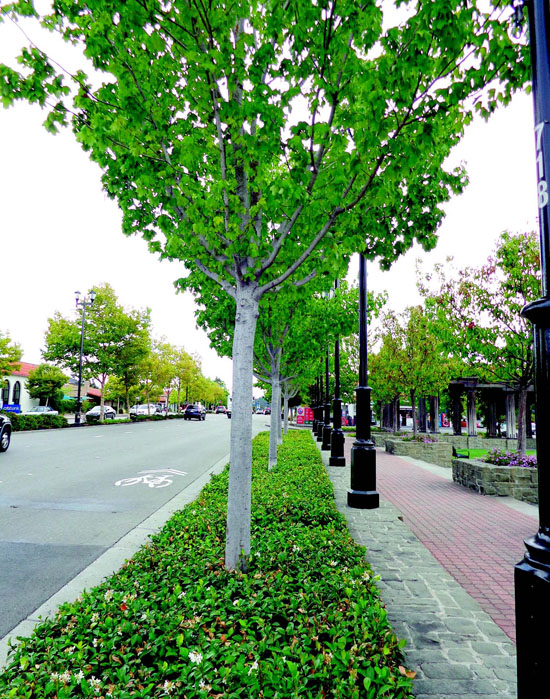|
|
Published August 12th, 2015
|
PG&E's Tree Problem
|
|
| By Cathy Tyson |
 |
| Trees near PG&E gas transmission lines will be evaluated throughout Lafayette as part of the Community Pipeline Safety Initiative. Photo C. Tyson |
Lafayette residents can expect to see tree by tree evaluations along gas transmission lines that dissect the city in the near future. The utility's concern is that vegetation and tree roots may create corrosion that can damage gas lines over time, creating a safety hazard.
 With gas lines running along Mt. Diablo Boulevard, through Briones, near the Lafayette-Moraga Regional Trail, St. Mary's Road, Happy Valley Road, and Olympic Boulevard, PG&E will be partnering with property owners of those parcels, the City of Lafayette, the East Bay Municipal Utility District and the East Bay Regional Park District to work together to address potential tree root damage that can affect gas transmission pipelines, so that first responders can quickly intervene in case of an emergency.
With gas lines running along Mt. Diablo Boulevard, through Briones, near the Lafayette-Moraga Regional Trail, St. Mary's Road, Happy Valley Road, and Olympic Boulevard, PG&E will be partnering with property owners of those parcels, the City of Lafayette, the East Bay Municipal Utility District and the East Bay Regional Park District to work together to address potential tree root damage that can affect gas transmission pipelines, so that first responders can quickly intervene in case of an emergency.
 At a recent city council meeting Lafayette resident and government relations manager for PG&E, Tom Guarino, highlighted a framework of principles hammered out at a recent meeting between the two agencies and the city "to proceed in a much more collaborative fashion."
At a recent city council meeting Lafayette resident and government relations manager for PG&E, Tom Guarino, highlighted a framework of principles hammered out at a recent meeting between the two agencies and the city "to proceed in a much more collaborative fashion."
 This effort is part of the Community Pipeline Safety Initiative, which strives to make safety improvements in gas transmission lines after the 2010 explosion in San Bruno, which killed eight people and injured 66. This is the second version of the plan; the first was launched two years ago, called Pipeline Pathways, which did not receive a warm reception.
This effort is part of the Community Pipeline Safety Initiative, which strives to make safety improvements in gas transmission lines after the 2010 explosion in San Bruno, which killed eight people and injured 66. This is the second version of the plan; the first was launched two years ago, called Pipeline Pathways, which did not receive a warm reception.
 With a top priority of safety, Guarino explains that they "rebooted the program." This particular component is part of an overall plan that includes pressure testing of gas lines, installing automatic gas valves, replacing transmission lines and more.
With a top priority of safety, Guarino explains that they "rebooted the program." This particular component is part of an overall plan that includes pressure testing of gas lines, installing automatic gas valves, replacing transmission lines and more.
 The utility will pay for an independent arborist, to join with representatives from PG&E, and Megan Canales, assistant planner for the city, who will serve as a project manager, along with EBMUD and EBRPD to go tree by tree to examine specimens that may need to be removed, or identify others that can be monitored, not axed, using technology to verify the proximity to a pipeline.
The utility will pay for an independent arborist, to join with representatives from PG&E, and Megan Canales, assistant planner for the city, who will serve as a project manager, along with EBMUD and EBRPD to go tree by tree to examine specimens that may need to be removed, or identify others that can be monitored, not axed, using technology to verify the proximity to a pipeline.
 The utility will be playing by the city rules this time around, agreeing to abide by Lafayette's strict tree protection ordinance. It will also pay for staff time to monitor the project and for the arborist.
The utility will be playing by the city rules this time around, agreeing to abide by Lafayette's strict tree protection ordinance. It will also pay for staff time to monitor the project and for the arborist.
 The other agencies have skin, or rather, trees in the game: EBMUD has trees on the reservoir property, and the EBRPD has numerous trees along the Lafayette-Moraga trail and at Briones.
The other agencies have skin, or rather, trees in the game: EBMUD has trees on the reservoir property, and the EBRPD has numerous trees along the Lafayette-Moraga trail and at Briones.
 At the moment, only 18 city-owned trees have been identified as a potential risk to a pipeline, according to city manager Steven Falk, but he added that more than 1,000 need further analysis.
At the moment, only 18 city-owned trees have been identified as a potential risk to a pipeline, according to city manager Steven Falk, but he added that more than 1,000 need further analysis.
 In the coming months, EBMUD, EBRPD, Lafayette and PG&E will be working together to come up with a common approach about how to handle problem trees and will present a plan to the city council sometime this fall.
In the coming months, EBMUD, EBRPD, Lafayette and PG&E will be working together to come up with a common approach about how to handle problem trees and will present a plan to the city council sometime this fall.

|
|
|
|
|
|
|
|
|
| |
|
|
|
|



